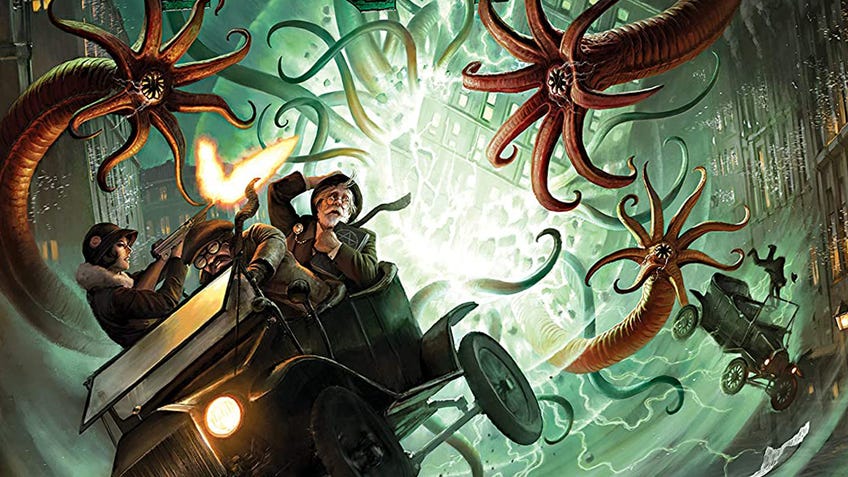Horror board games could be amazing if they took more risks
living and playing dangerously.
When it comes to board game themes, horror is undoubtedly a very popular choice for many tabletop gamers. From Dead of Winter to Arkham Horror, many of the most beloved modern board games of all time feature a spooky theme. There’s something about horror, whether it’s the dreadful in-game consequences of losing or the rich history of stories and characters to draw upon, that makes it such a compelling theme for designers, publishers and players.
But as much as I love my fair share of horror board games - it might actually be my favourite kind of theme in the whole of tabletop gaming - I can’t help but sigh and wonder what we might be missing out on. Horror is historically such an experimental genre and it’s been used in the past to explore some incredibly deep subjects, from the fears of motherhood to the terrors of capitalism, creating some of the most beloved fiction ever made. Tabletop roleplaying games have seen a surge in recent years of horror themed titles that push both thematic and gameplay boundaries, from Bluebeard’s Bride to Jiangshi: Blood in the Banquet Hall.
However, the same cannot be said for horror board games. The overall approach we’ve seen the board game industry take to horror as a theme is to largely adopt recognisable tropes of the genre and implement them into a game as set-dressing. It is important to note that it’s often the case in the tabletop gaming industry that the design of a board game will come first, with the theme following afterwards, meaning that it rarely takes precedence. However, I feel that horror should be the exception to this particular rule. It’s a theme that deserves to be more than just a decorative feature, but should be considered right from the very start of the creation process.
As a physically interactive experience, board games could do things with horror that no other source of entertainment could.
If this were the case, then horror board games might take some risks with their theme rather than playing it safe with just some artwork and a rulebook. Horror board games could have the potential to include some seriously innovative gameplay and narrative mechanics, considering that horror is a theme that can be deeply interwoven into an interactive experience. For example, horror tabletop roleplaying game Dread cleverly imbues horror into both its gameplay and storytelling elements, with players needing to pull blocks from a tumble tower everytime they attempt an action and the games master being encouraged to tell narratives that fit with terrifying situations - an isolated location, an overwhelmingly powerful monster and the player’s own dark pasts coming back to haunt them.

As a physically interactive experience, board games could do things with the horror genre that no other source of entertainment - even TRPGs - could achieve. A good example of a horror board game that does play around with interactive elements is Nyctophobia, a tabletop title that has one group of players navigating a board using only their hands - the creator, Catherine Stippel, was initially inspired to design the game for her blind uncle - whilst another player attempts to stalk them as a blood-thirsty killer.
The idea of using physical pieces to imitate an imaginary experience of blindly running through a forest whilst being hunted sounds incredible.
The premise behind the game is fairly standard - vampires and serial killers stalking teenagers in a wood - but the way that players interact with Nyctophobia is fascinating. The victims must work together to find key spaces on the board and survive long enough for the police to arrive, without being caught by the player controlling the hunter. Players need to use their hands to feel across the board, which contains little prongs that represent trees, remembering where certain paths are and communicating their findings to their teammates. All the time, the hunter player must attempt to cut off the victims and pounce on them when they’re at their most vulnerable.
I’ve not had a chance to play Nyctophobia, as copies aren’t too easy to come by in the UK, but I desperately want to. The idea of using physical pieces to imitate an imaginary experience of blindly running through a forest whilst being hunted sounds incredible, and it’s the kind of concept I wish other horror board games would take inspiration from. As we see more and more modern board games that introduce new and exciting ideas to the table - from Oath’s legacy-style save system to Descent: Legends of the Dark’s use of a companion app to tell an evolving narrative - I would love to see horror board games at the front of that pack.
There is hope for innovation for horror board games on the horizon, with recent examples of potentially exciting titles including the newly announced The Dark Quarter from Lucky Duck Games, which seems to promise some mature content in a tabletop title with a companion app. It’s not that horror board games have been boring in the past - far from it, in fact, with Eldritch Horror and Betrayal at House on the Hill being some of my favourite board games of all time - it’s just that I know they could do so much better.


